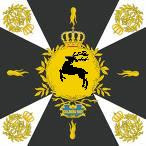I should update the blog on the progress towards the big and mad project to rebase all units with a massive expansion. I bought a stack of Luftberg infantry back at the beginning in November, and now we’re into May. Where does all the time go?
I’ve rebased a large amount of older units, plus painted and based a good wedge of the new-bought infantry, but there’s still enough to keep me very busy with painting. I’ve got about 14 or so ice-lolly sticks
With miniatures glued to each, which I base-coated white with the old expedient of a spray-can. Recently I moved them on yet further when I painted their bases green and the gaiters black for them all.
Now, I’ve a system up and running which runs as follows:
1) Paint facings on coat cuffs and tails (almost always blue, as I’ve painted a good number of red-facing regiments)
2) Paint collar, which usually means painting half the head as this’ll get redone later. As long as I get a neat line at the bottom of the collar, things are okay.
3) Repaint the head, hair & hat black, plus the sword handle & cartridge box. Most Luftbergers and Aschenbachers have black hair these days, oddly. There’s the odd brown-haired one, but that’s your lot. Blondes are so rare that they’d probably be pointed at and laughed at in the street. Primitive times… Sorry, where was I?
4) Skin-colours go on, completing the face and I also cover the hands – plus a good proportion of the still-white musket.
5) Brown paint now, doing up the musket and their equipment pack. A few steps later I’ll probably notice I’ve forgotten to paint the butt of the musket, and have to go back, swearing volubly. The Musket, being round, held to the body, and gripped two-handed, is proving to be spectacularly easy to overlook bits on. Still, as least the Aschenbachers hold theirs vertically, which is a bit better.
6) The miniature should be mostly there now. Some quick details follow, like silver for the bayonet & sword-handle, gold for the cartridge-box plate, etc. The most fiddly bit is the headband, typically white or yellow. Brushing it on can take a while, and I always seem to land the crown of the hat with an accidental brushing, so I need to redo the black here.
7) No miniature of this last collection has reached stage 7. I’ll do them en masse due to the awkwardness of it all, but this is where the miniatures get ‘dipped’ to add all the detailing and shading. Then, after being sprayed down with a protective coat, they’re ready to be based!
So what of the remaining figures, the Luftberg Cavalry & the Aschenbach Infantry & Cavalry? Well, it’s not cheap to get them all in one go, but I’ve hit on a good method to afford them. For the last few months, at work, I’ve been avoiding the vending machine and bringing in my own lunch, putting aside the £1 or £2 I would otherwise be spending. It’s such a small sum you never miss it, but by the end of the week that’s a fiver or so saved up. This has been going on for a while, and I now calculate I’ve saved up 90% of the money – only a little while to go, so that by the time I’ve finished the infantry I’m on now, I should be able to buy the remaining ‘lead mountain’ and start on them!
Normally such small-time personal accounting wouldn’t be worthwhile, but I’ve discovered something good from it. You know how you constantly think of launching other projects, different periods, and collecting different armies because of some great discount or range you’ve found? I’ve had that too, but by saving so gradually, you come to value the money reserve you’re fractionally gathering. It makes you think, very very carefully, about how much you’re spending, and on what.
In the time it’s taken me to save up for this purchase, I was convinced at various times I was going to spend it on plastic 25mm ACW armies; 6mm lead ACW armies; Medieval Hundred years’ war armies; Colonial Armies; WW1 armies of 1914-vintage; and possibly a 2mm epic-scale pair of armies for pretty much anything. In other words, I am a little bit flighty! I could’ve spent a fortune, but this blog and the project for remaking two damn good armies has kept me on course. Hooray for the penny-pinchers!


4 comments:
AMEN Brother!
I use a slightly different order of painting . . . but the key is your commentary (which I totally agree with) about not being overly careful with paint that will later be painted over.
-- Jeff
Agreed! Since I switched to acrylic paints (kinder on the sinuses) and developed my painting block system (similar to a laboratory test tube stand) my painting has speeded up by an order of magnitude. I follow the "three feet rule" too.
Cool. I drive myself insane with painting bits never-to-be-seen-again. Now i got onto acrylics, argh, better...
love this blog
Otto
Post a Comment